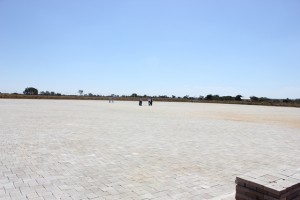 Calibration and validation (Calval) processes for earth observation (EO) are the foundation of being able to deliver quality EO data products that are fit for purpose and can be trusted by the scientific user community. The CSIR, in collaboration with the South African National Space Agency (SANSA) and other partners, is embarking on a project, sponsored by the South African Department of Science and Technology, to establish sound practice and local capability in the satellite EO Calval domain.
Calibration and validation (Calval) processes for earth observation (EO) are the foundation of being able to deliver quality EO data products that are fit for purpose and can be trusted by the scientific user community. The CSIR, in collaboration with the South African National Space Agency (SANSA) and other partners, is embarking on a project, sponsored by the South African Department of Science and Technology, to establish sound practice and local capability in the satellite EO Calval domain.
Calibration and Validation
Calibration is defined as the process of determining the quantitative response of a system or measuring instrument, to known and controlled inputs. It is the fundamental process by which an instrument is given the capability to perform measurements that are traceable to international standards, giving credibility to measurements performed with the calibrated instrument.
Satellite EO sensors are calibrated for various reasons, one important example is to be able to provide reliable continuous data that would be collected from various satellites over long periods. An instance where this is of particular importance is the use of EO sensors in tracking global processes, such as climate change. The effects of climate change can only be seen over decades that exceed the typical lifetime of a single satellite EO mission. In order to make such changes visible over long periods, careful calibration of satellite EO sensors is necessary to provide seamless and reliable measurement records.
The EO system can only deliver true value if the data products are trusted, adopted and applied by the user community. For this reason, a wider quality assurance function, validation, is needed. Validation is being able to confirm that the data products are reliable and fit for the purpose for which they were originally conceived and developed. The end goal of validation is the trust, adoption and application of the EO data products by the user community.
Successful validation also shows the integrity of the chain of custody, linking user and stakeholder needs to EO mission outcomes, good governance, spanning through to sound science and engineering.
Building a much needed skill base
There is a drive within South Africa to develop human capital with the correct skills and expertise to perform Calval functions for local satellite programmes, such as EO-SAT1, as well as be able to contribute to Calval processes at an international level. Their participation is also required in large scale programmes such as the Global Earth Observation System of Systems, an initiative aimed at harnessing a wide array of EO outcomes into a harmonised system to address nine major societal benefit themes. These interlinked themes include disasters, health, energy, climate, agriculture, ecosystems, biodiversity, water and weather.
International participation forms part of a broader Calval human capital and local capability development programme involving data users, scientific domain specialists, space systems engineers, metrologists and other interested and affected parties. The objectives of this Calval programme includes establishing a South African site or sites that are suitable for radiometric vicarious calibration of earth observing satellite sensors, as well as sensor spatial response (image quality), and building local human capital for the execution of calibration and validation field and laboratory tasks. This could include offering courses in satellite EO Calval. Supporting the local space industry in quality assurance for satellite earth observation products and executing regular field campaigns to build and maintain Calval capability is another objective of the programme. It aims to provide evidence to sponsors and the EO product user community that the local Calval capability is trustworthy, especially when coordinated Calval activities span across multiple organisations.
A collaborative Calval plan for EO-SAT1 is currently being developed.
The committee on earth observation satellites
The “space arm” of the Group on Earth Observation (GEO) is the Committee on Earth Observation Satellites (CEOS), who has been tasked with the international coordination of satellite EO resources in support of the GEO societal benefit themes. CEOS includes a number of working groups, such as the Working Group on Calibration and Validation (WGCV). Sub-groups of WGCV address various major classes of EO sensors or applications and include
• Infrared and Visible Optical Sensors
• Synthetic Aperture Radar (SAR)
• Microwave Sensors (MSSG)
• Terrain Mapping (TMSG)
• Land Product Validation (LPV)
• Atmospheric Composition (ACSG)
For the EO-SAT1 mission, the IVOS sub-group is the most relevant and South Africa maintains a continuous presence at IVOS by attending meetings and contributing to workgroup activities.
Pre-Launch and On-Orbit Calval
Calval activities span the complete lifecycle of a satellite mission from conception through to de-orbiting or disposal. This includes both the pre-launch phase as well as the on-orbit commissioning and operational phases. Calibration activities transition from laboratory-based measurements on the ground to a variety of on-orbit methodologies for monitoring the system calibration during the operational phase after launch. Validation plans for the mission must also grow together with mission conception and implementation. Validation is performed primarily on EO data products and therefore must include experienced product users. Simulation of data products can be an invaluable tool for providing users with samples of the expected EO data products for evaluation before final system implementation. End-to-end modelling of user targets through to prototype product delivery algorithms would enable such simulations.
For more information on the Paardefontein Calibration Site please click here
dpss@csir.co.za
